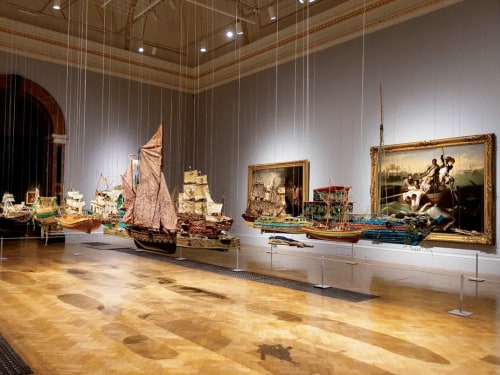
On a mission to right imperial wrongs, “Entangled Pasts, 1768–now: Art, Colonialism and Change” knotted together more than a hundred historical and contemporary works to explore “art and its role in shaping narratives of empire.” Each section of the show, curated by Dorothy Price, Esther Chadwick, Cora Gilroy-Ware, and Sarah Lea, tackled a different aspect of colonial misconduct. “The Aquatic Sublime,” for instance, conjured the terrible beauty of nature—and man’s desire to dominate it—by staging a face-off between J. M. W. Turner’s Whalers, ca. 1845, with its boat lashed by furious swirls of wind and rain, and John Akomfrah’s video installation Vertigo Sea, 2015, where bewitching mist-shrouded seascapes make fluid links among slavery, migration, and colonial conquest.
Many other old favorites resurfaced, often lavishly re-presented. Isaac Julien’s Lessons of the Hour, 2019, a video installation about African American abolitionist Frederick Douglass—the most photographed American in the nineteenth century—was enclosed in a red-curtained enclave, replicating an early photography studio. In Hew Locke’s Armada, thirty-seven miniature cargo ships, fishing boats, caravels, and galleons—constructed by the British Guyanese artist between 2017 and 2019 and dangling dramatically from the ceiling—referenced the entwined histories of colonial exchange and the current refugee crisis. Peeking across Locke’s swaying ships, visitors sighted another familiar face: a Georgian gentlewoman of mixed race posing in a bejeweled turban with her white cousin in David Martin’s 1779 Portrait of Dido Elizabeth Belle Lindsay and Lady Elizabeth Murray. Only slightly less well-known was Keith Piper’s The Coloureds’ Codex, An Overseers’ Guide to Comparative Complexion, 2007, a wooden display case containing fifteen pots of pigment documenting the shades of slavery: jet black, chocolate brown, and the icing white of the overseer’s skin. Piper’s mockery of racial stereotyping was cleverly offset by Henry Weekes’s 1859 alabaster-hued bust of an anonymous African woman. Turning a corner, visitors met Lubaina Himid’s Naming the Money, 2004, seventy colorful life-size cutouts of figures inspired by Africans depicted in European art, including dancers and musicians.
Its theme aside, “Entangled Pasts” functioned as a roll call of Black British art history. But that meant that the legacies of British India, and Asia in general, played second fiddle. Despite the show’s promise to tackle the British Empire’s geographically divergent evils, South Asian artists were thin on the ground. The section “Tradition and Appropriation,” where both the British Indian Singh Twins and American Pakistani Shahzia Sikander made appearances, only accentuated the problem. The Twins’ Indiennes: The Extended Triangle, 2018—part of their extensive, ongoing series of fabric light boxes begun in 2017, “Slaves of Fashion”—depicts a sari-draped, gun-toting version of Fanny Eaton, the Jamaican-British model for the Pre-Raphaelites, partly inspired by Joanna Wells’s 1861 portrait of her. This worked well since the show also included a portrait of Eaton by Frederick Sandys from ca. 1859–60. But “Slaves of Fashion” is about the present as much as the past: The series unravels the complicated connections between contemporary fashion and Britain’s imperial embroilment in India’s textile industry. Including more than one work from it would have allowed for a fuller understanding of the threads that continue to bind South Asia and Britain today.
The fate of Yinka Shonibare’s statue Justice for All, 2019, was instructive. A globe-headed replica of F. W. Pomeroy’s 1905–1906 Lady Justice who stands atop London’s Old Bailey, she sports a fuchsia dress made with Shonibare’s signature Dutch wax fabric-inspired designs while her turquoise fiberglass arms sport a diagonal pattern simulating Indonesian batik. I had met Shonibare’s sculpture in 2020, when she debuted in Singapore’s Old Parliament House. The Neo-Palladian building was once owned by the British East India Company, but it also housed the first parliaments of the newly independent state. Occupying center stage at this historic spot, Shonibare’s Lady Justice celebrated hybrid identity, her mixed motifs an embodiment of Singapore’s multicultural, multiracial society. Transported to the RA, whose wall text omitted mention of her Singapore debut, the once-triumphant Lady looked forlorn. Casting long, lonely shadows, she pointed toward the exit. Was she (unintentionally?) telling us that justice for all is an unrealistic ambition for a single exhibition?